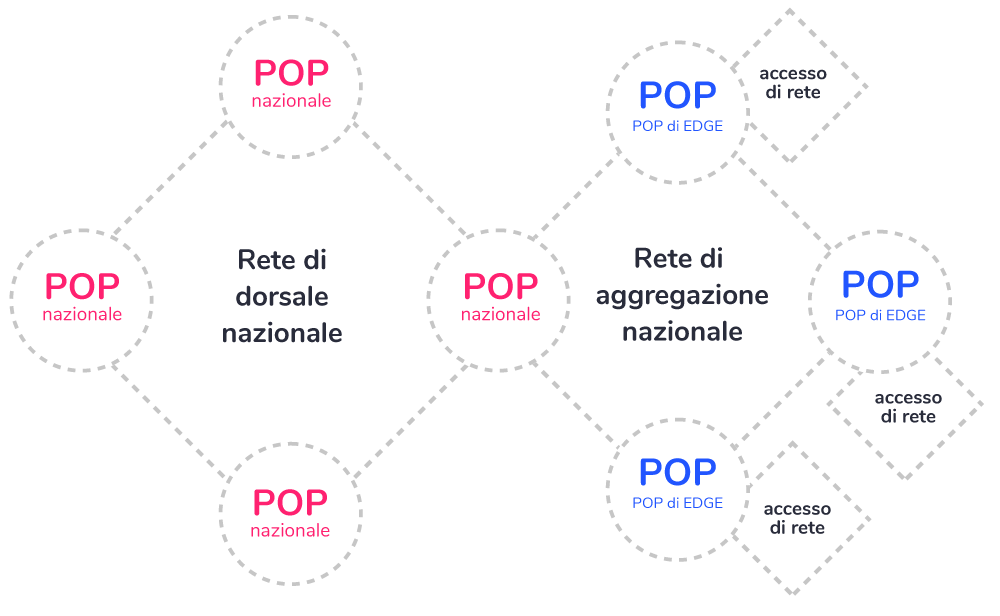La reteRete Nel linguaggio informatico il termine rete definisce un insieme di dispositivi hardware e software che, collegati tra loro, permettono lo scambio e la condivisione di risorse, dati o informazioni. In una rete di computer i dispositivi che generano, instradano e terminano i dati sono chiamati nodi della rete. d’accesso FTTHFTTH "Fiber to the Home" è la tecnologia che collega i POP, siti nelle centrali, alle unità immobiliari degli utenti finali con la fibra ottica. di Open Fiber è realizzata secondo lo standard PONPON È l’acronimo di Passive Optical Network, ossia rete ottica passiva, che descrive tutte le tipologie di reti ottiche che non hanno apparati attivi tra punto iniziale e punto finale. Una tipologia di queste è quella utilizzata per portare il collegamento in fibra ottica all'utenza finale mediante un'architettura di tipo punto-multipunto che consente di usare una singola fibra ottica per raggiungere più destinatari, mediante splitter ottici non alimentati. (Passive Optical Network), rispettandone la roadmap evolutiva per garantire la migliore connessione di sempre.
L’infrastruttura di rete di Open Fiber utilizza la tecnologia di accesso fisso GPONGPON Acronimo di Gigabit Passive Optical Network è una tecnologia d’accesso attiva per la fornitura di connettività su infrastrutture PON FTTH. Si definisce attiva in quanto viene implementata utilizzando elementi di rete attivi quali OLT, in centrale, e ONT, nelle case degli utenti. L’infrastruttura di rete sottostante è invece passiva (Passive Optical Network) perché impiega esclusivamente elementi che non necessitano di alimentazione, come gli splitter che permettono di separare la fibra ottica in molteplici collegamenti che si diramano verso i diversi edifici riducendo la quantità di fibra ottica e di apparecchiature di rete necessarie. La tecnologia GPON fornisce un’ampiezza di banda senza precedenti (fino a 2,5 Gb/s di velocità in downstream e 1,25 Gbps in upstream) e una maggiore distanza dalla centrale, consentendo ai provider di servizi di abilitare applicazioni a uso intensivo di larghezza di banda., ad oggi la più solida su reti PON. La tecnologia GPON vede, recentemente, l’affiancarsi di tecnologie più avanzate: XGS PON (collegamento in fibra otticaFibra ottica È un cavo realizzato con una fibra di vetro attraverso il quale viene trasmesso un segnale luminoso anche su grandi distanze per l’accesso di reti a banda larga. Rispetto ai cavi in rame, la fibra ottica è in grado di trasmettere segnali molto più velocemente, fino a 40 Gigabit al secondo. È, pertanto, ideale per grandi quantità di dati da trasferire rapidamente; è inoltre insensibile alle interferenze esterne (interferenze elettromagnetiche, variazioni di temperatura, ecc.). Mentre la velocità, la qualità e la sicurezza della trasmissione dei dati sono indubbiamente i vantaggi della fibra ottica, il costo elevato della loro installazione costituisce uno svantaggio limitante per chi realizza la rete. Leggi la news per saperne di più: “Fibra ottica, cos’è e come funziona”. capace di trasmettere e ricevere dati alla velocità massima di 10 Gbit/s) e la successiva evoluzione NG-PON (uno standard di reti di telecomunicazioni capace di raggiungere una velocità di navigazione totale di 40 Gbit/s), per raggiungere prestazioni maggiori in termini di capacità trasmissiva.
Tecnologia PON e AON a confronto
La tecnologia PON (Passive Optical Network) consente la realizzazione di infrastrutture di rete in fibra ottica FTTH in modalità punto-multipunto, utilizzando esclusivamente fibra e componenti passivi, quali splitterSplitter Noto anche come splitter ottico, è un dispositivo passivo (ossia che non necessita di alimentazione) utilizzato nella tecnologia PON atto a smistare e combinare l’energia delle onde luminose. Lo splitter si occupa della replicazione del segnale ottico proveniente da una fibra, verso un numero predefinito di altre fibre (splitter 1 a 8, 1 a 4 e così via) e combina i segnali ottici provenienti dai diversi client. ottici e giunti, che, installati lungo l’intero tratto trasmissivo, non necessitano di essere alimentati da rete elettrica. L’esigenza di un’alimentazione diretta è dunque circoscritta a livello di centrali/POPPOP Il POP, "Point of Presence", è localizzato presso le Cabine Primarie di Enel, ma non solo; agisce anche come meet-me-room per gli Operatori. Contiene gli apparati OLT di ciascun Operatore, nonché il sistema di monitoraggio OTDR.. Questi aspetti si traducono in un importante vantaggio della tecnologia, riducendo costi e possibilità di guasti, a differenza di quanto accade con le reti in rame.
In alternativa alla rete ottica passiva, il collegamento di un utente finale può avvenire utilizzando una modalità Active Optical Network (AON). Tale configurazione prevede un’architettura punto-punto quindi in fibra dedicata con l’utilizzo di apparati attivi (switch, routerRouter È un dispositivo di rete che instrada pacchetti di dati tra reti diverse o tra sottoreti di una stessa rete. I grandi router dei carrier stabiliscono i percorsi di traffico sulle dorsali internet, i più familiari router casalinghi si limitano a scambiare pacchetti tra la rete domestica e quella dell’Operatore, che a sua volta sfocia nella internet mondiale.). Nonostante il sistema Active Optical Network sia maturo e funzionante, il costo di implementazione che ne deriva è superiore a quello della rete ottica passiva (PON).
L’architettura di Open Fiber
La rete di accesso FTTH Open Fiber è una rete passiva multi-operatore che supporta l’utilizzo di tecnologie “punto-multipunto” e “punto-punto”.
L’architettura Open Fiber “punto-multipunto” si basa sulla realizzazione di una rete in cui le risorse ottiche di concentrazione (Alberi PON) sono condivise dai diversi attori, mentre il collegamento finale con l’utente è realizzato con una singola fibra dedicata.
Per consentire la raccolta di utenza in modo efficiente si è introdotto un elemento di rete, costituito da un armadio di permutazione (coincidente con il nodo PFSPFS Il PFS è il nodo presso il quale avvengono il secondo livello di splitting e le permutazioni delle linee cliente sui vari Operatori.) che consente di collegare, in modo flessibile, ogni cliente con le risorse ottiche dell’Operatore con cui ha sottoscritto il servizio.










